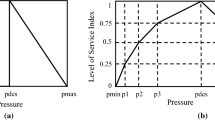Abstract
Optimal design and rehabilitation scheduling of water distribution networks (WDNs) have been often dealt separately over the past few decades. However initial design (which is named as static design in this paper) has indubitable influence on the operational condition and rehabilitation scheduling of network. This paper introduces an approach for simultaneous optimization of initial design and rehabilitation scheduling of WDNs during their life cycle. In this approach which is named as dynamic design, pipe diameters in the first year and their rehabilitation/replacement in the next years of the expected life of the network are determined considering the nodal demands growth and increase in pipes’ roughness. The proposed model consists of a multiobjective ant colony optimization engine linked to a pressure dependent analysis model and a pipe break prediction model. This paper introduces the following contributions: (1) it implements dynamic design based on the pressure dependent analysis with considering leakage; (2) a support vector machine based sub model is used for pipe break prediction. Then pipe breaks and their repair costs are considered in dynamic design process; (3) a new reliability index is used as one of the objective functions. Two networks are used to investigate the impact of static and dynamic designs on the reliability and total cost of design and rehabilitation of WDNs during their life cycle. The results show that the dynamic design produces more reliable and lower cost networks in comparison to the ones resulted from either static design or rehabilitation scheduling separately.







Similar content being viewed by others
References
Afshar A, Sharifi F, Jalali MR (2009) Non-dominated archiving multi-colony ant algorithm for multi-objective optimization: application to multi-purpose reservoir operation. Eng Optim 41(4):313–325
Christodoulou S, Ellinas G (2011) Ant colony optimization for level of service improvements in piping networks. European Water 33:3–10
Colebrook CF, White CM (1937) The reduction of carrying capacity of pipes with age. Journal of the Institution of Civil Engineers 7(1):99–118
Creaco E, Franchini M, Walski TM (2014) Accounting for phasing of construction within the design of water distribution networks. J Water Resour Plan Manag 140(5):598–606
Cunha MC, Sousa J (1999) Water distribution network design optimization: simulated annealing approach. J Water Resour Plan Manag 125(4):215–221
Dorigo, M (1992) Optimization, learning and natural algorithms. Ph.D. thesis, Polytechnic University of Milan, Milan
Dridi L, Mailhot A, Parizeau M, Villeneuve JP (2009) Multiobjective approach for pipe replacement based on bayesian inference of break model parameters. J Water Resour Plan Manag 135(5):344–354
Duan N, Mays LW, Lansey KE (1990) Optimal reliability-based design of pumping and distribution systems. J Hydraul Eng 116(2):249–268
Fujiwara O, Khang DB (1990) A two-phase decomposition method for optimal design of looped water distribution networks. Water Resour Res 26(4):539–549
Germanopoulos G (1985) A technical note on the inclusion of pressure dependent demand and leakage terms in water supply network models. Civ Eng Syst 2(3):171–179
Ghajarnia N, Haddad OB, Kouchakzadeh S (2012) Multiobjective dynamic design of urban water distribution networks. Journal of Iran-Water Resources Research 7(4):21–40 (in Farsi)
Lamont PA (1981) Common pipe flow formulas compared with the theory of roughness. J Am Water Works Assoc 73(5):274–280
Mohan S, Jinesh Babu KS (2010) Optimal water distribution network design with honey-bee mating optimization. J Comput Civ Eng 24(1):117–126
Nash J (1950) The bargaining problem. Econometrica 18(2):155–162
Puccini GD, Blaser LE, Bonetti CA, Butarelli A (2016) Robustness-based design of water distribution networks. Water Utility Journal 13:13–28
Saleh S, Tanyimboh TT (2016) Multi-directional maximum-entropy approach to the evolutionary design optimization of water distribution systems. Water Resour Manag 30(6):1885–1901
Seyoum AG, Tanyimboh TT, Siew C (2016) Practical application of penalty-free evolutionary multi-objective optimisation of water distribution systems. Water Utility Journal 12:49–55
Shirzad A, Tabesh M (2016) New indices for reliability assessment of water distribution networks. J Water Supply Res Technol AQUA 65(5):384–395
Shirzad A, Tabesh M, Farmani R, Mohammadi M (2013) Pressure-discharge relations with application in head driven simulation of water distribution networks. J Water Resour Plan Manag 139(6):660–670
Shirzad A, Tabesh M, Farmani R (2014) A comparison between performance of support vector regression and artificial neural network in prediction of pipe burst rate in water distribution networks. KSCE J Civ Eng 18(4):941–948
Siew C, Tanyimboh TT, Seyoum AG (2014) Assessment of penalty-free multi-objective evolutionary optimization approach for the design and rehabilitation of water distribution systems. Water Resour Manag 28(2):373–389
Spiliotis M (2014) A particle swarm optimization (PSO) heuristic for water distribution system analysis. Water Utility Journal 8:47–56
Stutzle T, Hoos HH (2000) Max-min ant system. Futur Gener Comput Syst 16(8):889–914
Young HP (1993) An evolutionary model of bargaining. J Econ Theory 59(1):145–168
Zheng F, Qi Z, Bi W, Zhang T, Yu T, Shao Y (2017) Improved understanding on the searching behavior of NSGA-II operators using run-time measure metrics with application to water distribution system design problems. Water Resour Manag. doi:10.1007/s11269-016-1564-7
Author information
Authors and Affiliations
Corresponding author
Rights and permissions
About this article
Cite this article
Shirzad, A., Tabesh, M. & Atayikia, B. Multiobjective Optimization of Pressure Dependent Dynamic Design for Water Distribution Networks. Water Resour Manage 31, 2561–2578 (2017). https://doi.org/10.1007/s11269-017-1602-0
Received:
Accepted:
Published:
Issue Date:
DOI: https://doi.org/10.1007/s11269-017-1602-0




